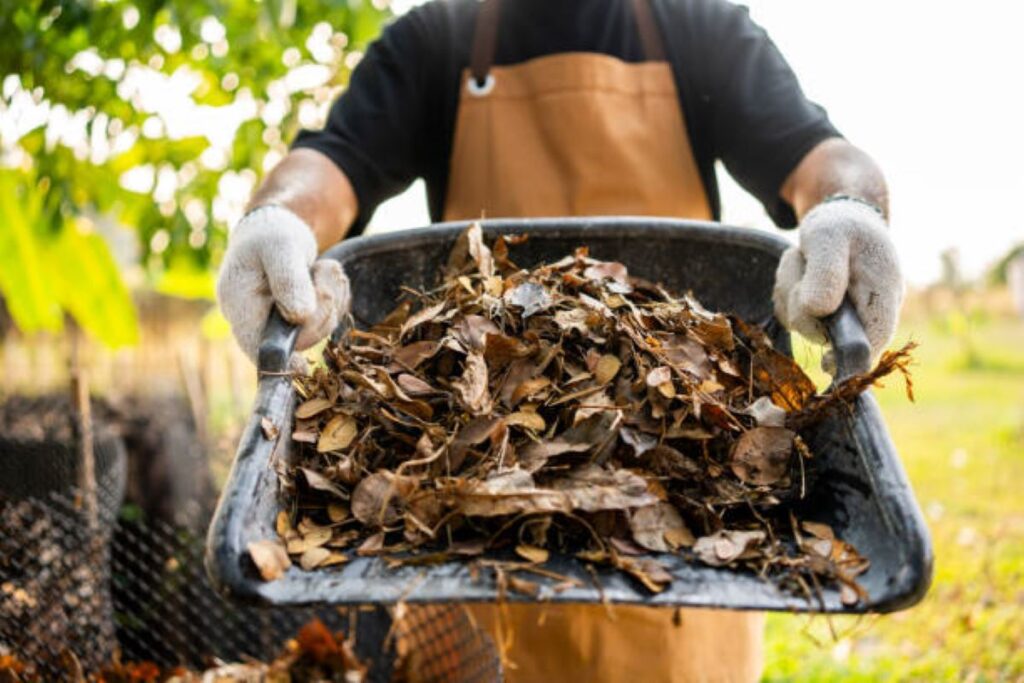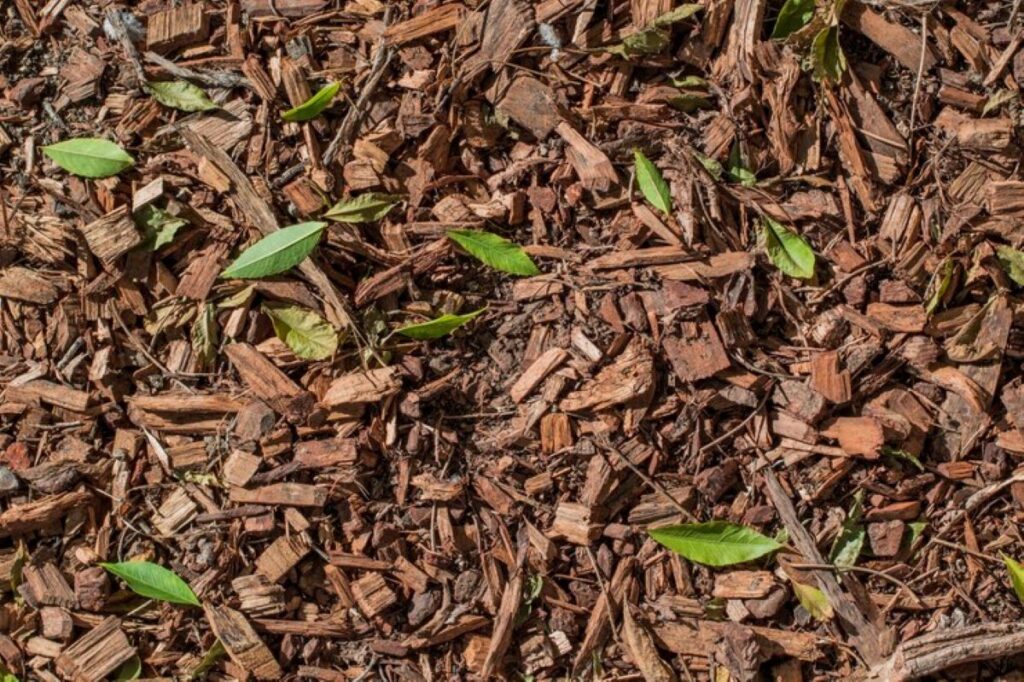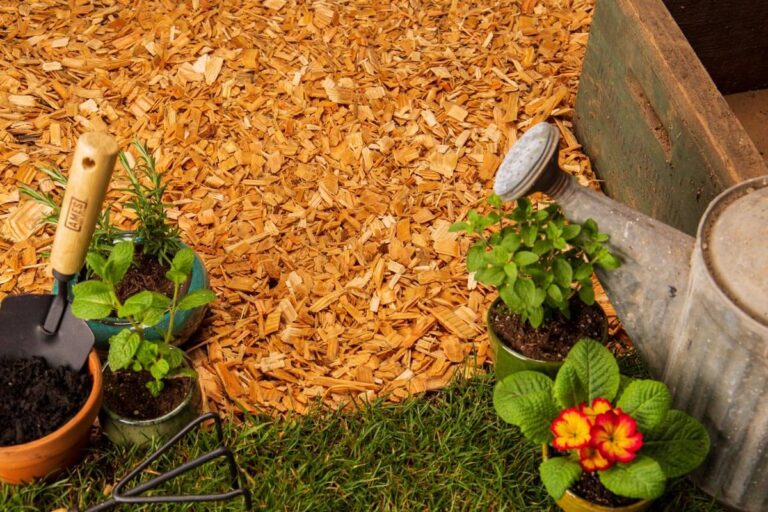Wood mulch is a key ingredient in modern gardening practices, turning ordinary gardens into flourishing, low-maintenance spaces. Made from shredded or chipped tree bark and wood, this natural material has become a go-to choice for gardeners.
The Need for Time-Efficient Gardening Solutions
The increasing popularity of wood mulch can be attributed to our fast-paced lifestyle, where time-saving gardening solutions are crucial. Gardeners today are looking for ways to keep their outdoor areas looking beautiful without spending hours on maintenance. Wood mulch strikes the perfect balance.
The Benefits of Wood Mulch
Wood mulch offers three main advantages:
- Natural Beauty: Creates an elegant, polished appearance that enhances garden aesthetics
- Practical Benefits: Reduces watering needs and suppresses weed growth
- Time Efficiency: Minimises routine maintenance tasks
The Sustainable Choice for Gardens
But it’s not just its looks that make wood mulch popular. It also has some great qualities that make it a smart choice for eco-friendly gardening:
- Regulating soil temperature
- Retaining moisture
- Gradually breaking down to enrich the soil
These qualities create a self-sustaining environment that promotes plant health while reducing the need for constant care.
A Solution for Landscapers and Home Gardeners
Both professional landscapers and home gardeners see wood mulch as an essential part of creating gardens that stay beautiful with minimal effort. This natural solution turns high-maintenance areas into manageable, thriving landscapes where gardeners can relax and enjoy their outdoor spaces instead of always working on them.
What Are the Advantages of Using Wood Mulch in a Low-Maintenance Landscape?
Wood mulch offers several practical benefits that support a low-maintenance approach to landscaping:
- Aesthetic Appeal: The natural look of wood mulch creates a polished, cohesive appearance across garden beds. Different types of wood provide various colour options, allowing gardeners to enhance their existing landscape design.
- Temperature Regulation: Wood mulch helps maintain optimal temperatures for plants. It keeps the soil cool during hot weather and retains warmth during cold spells, protecting plant roots from extreme temperature fluctuations.
- Moisture Retention: Wood mulch is effective at conserving moisture in the soil. It reduces water evaporation, creates consistent moisture levels, and minimises the need for frequent watering. This is particularly beneficial in areas with limited water resources or during dry seasons.
- Weed Suppression: Wood mulch acts as a natural barrier against weeds. It blocks sunlight from reaching weed seeds, preventing their germination and growth. This reduces the reliance on chemical herbicides and manual weeding efforts.
- Erosion Prevention: Wood mulch protects garden beds from erosion caused by rainfall or wind. It absorbs the impact of raindrops, reducing soil displacement and preventing topsoil loss. This helps maintain the structure of garden beds and promotes healthy plant growth.
These advantages make wood mulch an essential element in creating sustainable, low-maintenance landscapes that thrive with minimal intervention.
How Does Wood Mulch Contribute to Soil Health Over Time?
Wood mulch serves as a natural soil enhancement system through its gradual decomposition process. As organic matter breaks down, it releases essential nutrients into the soil, creating a rich environment for plant growth.
The decomposition cycle follows a specific pattern:
- Initial Stage: Beneficial bacteria and fungi begin breaking down the wood fibres
- Middle Phase: Nutrients like nitrogen, phosphorus, and potassium are released
- Final Stage: Complex organic compounds transform into humus
This natural process creates an ideal habitat for mycorrhizal fungi, which form symbiotic relationships with plant roots. These beneficial fungi:
- Extend their network through the soil, increasing nutrient absorption
- Break down complex minerals into forms plants can readily use
- Improve soil structure through the production of glomalin
The ongoing decomposition of wood mulch delivers sustained benefits to soil health:
- Enhanced Soil Structure
- Improved water infiltration
- Better root penetration
- Reduced soil compaction
- Increased Microbial Activity
- Higher populations of beneficial organisms
- Enhanced nutrient cycling
- Natural disease suppression
- Improved Chemical Properties
- Balanced pH levels
- Enhanced cation exchange capacity
- Steady nutrient release
Research shows gardens with consistent wood mulch application demonstrate improved soil organic matter content within 2-3 years. This enriched soil environment supports robust plant growth through:
- Stronger root development
- Enhanced nutrient uptake
- Improved stress tolerance
- Increased disease resistance
The gradual nature of wood mulch decomposition ensures these benefits continue long-term, creating a self-sustaining cycle of soil improvement. As the mulch breaks down, it integrates with the existing soil structure, building layers of nutrient-rich organic matter that support healthy plant growth year after year. You may like to visit https://prickofthespindle.com/wood-chips-vs-mulch-which-is-best-for-your-gardens-needs/ to check out more about Wood Chips vs Mulch: Which is Best for Your Garden’s Needs?
Why Is Wood Mulch Considered an Environmentally Sustainable Option for Gardeners?
Wood mulch is a great example of sustainable gardening practices, offering significant environmental benefits that go beyond basic landscaping needs. Its natural composition creates a harmonious relationship with the environment, supporting eco-friendly gardening methods.
Water Conservation
One of the biggest environmental advantages of wood mulch is its ability to conserve water. Its moisture-retaining properties create a protective barrier that reduces water evaporation from the soil by up to 70%. This remarkable water retention leads to:
- Reduced irrigation requirements
- Lower water consumption
- Decreased strain on local water resources
- Protection of plant roots during dry spells
Carbon Footprint Reduction
The environmental impact of wood mulch also includes reducing carbon footprint through decreased maintenance needs:
- Minimised Mowing Requirements: Mulched areas require less frequent mowing
- Reduced Fuel Consumption: Less equipment usage means lower emissions
- Decreased Chemical Usage: Natural weed suppression reduces herbicide needs
- Lower Energy Input: Reduced maintenance translates to less power tool usage
Additional Environmental Benefits
Wood mulch’s natural composition provides additional environmental benefits:
- Biodegradable material returns nutrients to the soil
- Local sourcing reduces transportation emissions
- Repurposing of tree waste prevents landfill disposal
- Creation of wildlife habitats for beneficial insects

The Sustainable Cycle of Wood Mulch
The sustainable cycle of wood mulch demonstrates nature’s efficiency. As trees are trimmed or removed for safety or development purposes, their wood becomes mulch, continuing to serve the environment. This closed-loop system supports local ecosystems while providing practical benefits for gardeners.
Alignment with Water-Conscious Landscaping
The use of wood mulch aligns with water-conscious landscaping practices, making it an ideal choice for environmentally aware gardeners. Its natural properties help create resilient gardens that require fewer resources to maintain, supporting long-term environmental sustainability.
How Can Proper Application Techniques Enhance the Effectiveness of Wood Mulch in a Low-Maintenance Landscape?
Proper application techniques play a crucial role in maximising wood mulch benefits while preventing potential issues in garden maintenance. The correct depth of mulch application serves as a fundamental factor in achieving optimal results.
Recommended Depth Guidelines:
- 2-3 inches for established plants and trees
- 1-2 inches for annual beds
- 4 inches for areas with severe weed problems
- Reduced depth of 1 inch near plant stems
A common mistake gardeners make is creating “mulch volcanoes” – piling mulch against tree trunks or plant stems. This practice can lead to:
- Bark decay
- Root rot
- Pest infestations
- Fungal growth
- Restricted air circulation
The proper application method involves creating a slight depression around plant stems, forming a “doughnut” shape. This technique:
- Prevents water from pooling against stems
- Allows proper air circulation
- Reduces disease risk
- Maintains plant health
When applying wood mulch, spreading it evenly across the garden bed helps achieve consistent benefits. The mulch layer should:
- Cover the soil completely
- Maintain uniform thickness
- Avoid compaction
- Allow water penetration
Professional gardeners recommend refreshing the mulch layer when its depth falls below 1 inch. This practice maintains the protective barrier while ensuring plants receive maximum benefits from the mulch application.
For sloped areas, slightly thicker applications might be necessary to prevent erosion. The mulch particles interlock over time, creating a stable surface that resists water runoff while maintaining soil moisture levels.
What Are the Maintenance Requirements for Gardens Using Wood Mulch?
Gardens with wood mulch require specific maintenance practices to maintain their effectiveness and aesthetic appeal. A well-maintained mulched garden delivers substantial labour-saving benefits while supporting plant health.
Reapplication Schedule
- Light-coloured mulches need replacement every 1-2 years
- Dark hardwood mulches last 3-4 years before requiring renewal
- Areas with heavy rainfall or strong sun exposure need more frequent reapplication
- Signs indicating mulch replacement needs:
- Significant colour fading
- Visible soil patches
- Reduced depth below 2 inches
- Decomposed material mixing with soil
Labour-Saving Benefits
Wood mulch creates a self-maintaining garden environment through:
- Reduced Watering RequirementsMoisture retention in soil reduces watering frequency by 25-50%
- Plants develop deeper root systems requiring less frequent irrigation
- Natural rainfall penetrates effectively through mulch layers
- Minimised Weeding TasksDense mulch layer blocks sunlight from reaching weed seeds
- Any emerging weeds are easily removed from loose mulch surface
- Reduced weed growth means less time spent on manual removal
Seasonal Maintenance Tips
- Spring: Add fresh mulch after soil warming
- Summer: Monitor moisture levels beneath mulch
- Autumn: Remove fallen leaves from mulch surface. For effective leaf removal, consider using these tips to make the process easier and more efficient.
- Winter: Check mulch depth remains adequate for root protection
The decomposition of wood mulch adds valuable organic matter to the soil, reducing the need for additional fertiliser applications. This natural breakdown process supports healthy soil biology and plant growth while maintaining a neat garden appearance with minimal intervention from gardeners.
How Do Premium Hardwood Mulches Compare to Other Types When It Comes to Longevity and Durability?
Premium hardwood mulches stand out from other varieties through their exceptional staying power in garden landscapes. The dense fibrous structure of hardwood creates a robust barrier that maintains its form and function for extended periods.
Decomposition Rates of Different Mulch Types
Different mulch types demonstrate varying decomposition rates:
- Premium Hardwood Mulch: 5-7 years
- Pine Bark Mulch: 3-4 years
- Cedar Mulch: 4-5 years
- Straw Mulch: 1-2 years
Natural Characteristics Contributing to Durability
The superior durability of hardwood mulch stems from its natural characteristics:
- Dense wood fibre composition
- High lignin content
- Resistance to compaction
- Natural weather resistance
These properties allow hardwood mulch to maintain its structural integrity whilst gradually releasing nutrients into the soil. The slower decomposition rate means less frequent replacement cycles, reducing both maintenance costs and labour requirements.
Creating a Stable Environment for Plant Growth
Premium hardwood mulches create a stable environment for plant growth through:
- Consistent Coverage: The weight and density prevent displacement by wind or rain
- Uniform Decomposition: Even breakdown across the garden bed
- Colour Retention: Maintains aesthetic appeal for longer periods
- Structural Stability: Resists matting and compaction
The investment in premium hardwood mulch pays dividends through reduced replacement frequency and enhanced garden protection. Gardens utilising hardwood mulch benefit from sustained coverage that maintains its effectiveness throughout multiple growing seasons.

Weather Resistance for Specific Garden Conditions
Hardwood mulch’s natural resistance to weather elements makes it particularly suitable for:
- Sloped garden beds
- Areas with high rainfall
- Exposed garden spaces
- High-traffic landscaping zones
The robust nature of hardwood mulch creates a reliable foundation for low-maintenance landscaping, delivering long-term benefits that surpass those of alternative mulching materials.
How Does Wood Mulch Support Water-Conscious Landscaping Practices?
Wood mulch plays a crucial role in landscaping strategies that aim to be resistant to drought. It does this by creating a protective barrier between the soil and the atmosphere. This natural shield can reduce water evaporation rates by up to 70%, allowing gardens to flourish with significantly less irrigation.
Water Retention Capabilities of Wood Mulch
During extended dry periods, wood mulch shows exceptional ability to retain water:
- Reduces soil temperature fluctuations by 8-13°C
- Creates air pockets that trap moisture near plant roots
- Prevents water runoff during heavy rainfall events
- Maintains consistent soil humidity levels
Benefits for Drought-Tolerant Plants
The moisture-regulating properties of wood mulch make it an ideal companion for plants that are resistant to drought. When used in conjunction with native species and xeriscaping techniques, wood mulch helps establish strong root systems that require minimal additional watering.
Reduction in Water Consumption
Research indicates that gardens with proper application of wood mulch can reduce their water consumption by:
- 25% decrease in frequency of irrigation
- 30-50% reduction in overall water usage
- Extended periods between necessary watering cycles
Contribution to Broader Water Conservation Efforts
The water conservation benefits of wood mulch go beyond individual gardens. By reducing water demands, landscapes that are mulched contribute to larger water conservation efforts, especially in areas that are susceptible to drought or have water restrictions. This natural solution enables gardeners to maintain beautiful, thriving gardens while also following responsible practices for managing water resources.
How Can Gardeners Make the Most of Wood Mulch for a Low-Maintenance Landscape?
Successful integration of wood mulch into garden design requires strategic planning and proper application techniques. Gardeners can maximise the benefits of wood mulch through these proven practices:
- Create defined garden beds with clear borders to contain mulch effectively
- Apply a 2-3 inch layer of premium hardwood mulch around plants and trees
- Maintain a mulch-free zone of 3-4 inches around plant stems and tree trunks
- Refresh mulch layers annually or as needed when decomposition occurs
Wood mulch serves as a cornerstone for sustainable garden design by:
- Reducing water consumption through enhanced moisture retention
- Minimising maintenance needs with natural weed suppression
- Supporting soil health through gradual nutrient release
- Creating visual appeal with natural textures and colours
The aesthetic and practical advantages of wood mulch make it an essential element for gardeners seeking to establish low-maintenance landscapes. Its ability to enhance soil health while reducing routine garden tasks allows property owners to maintain beautiful outdoor spaces with minimal effort.
For optimal results, gardeners should select high-quality hardwood mulches from reputable suppliers. This investment in premium materials ensures longer-lasting coverage and maximum benefits for both plants and soil structure, creating a sustainable foundation for years of reduced garden maintenance.


